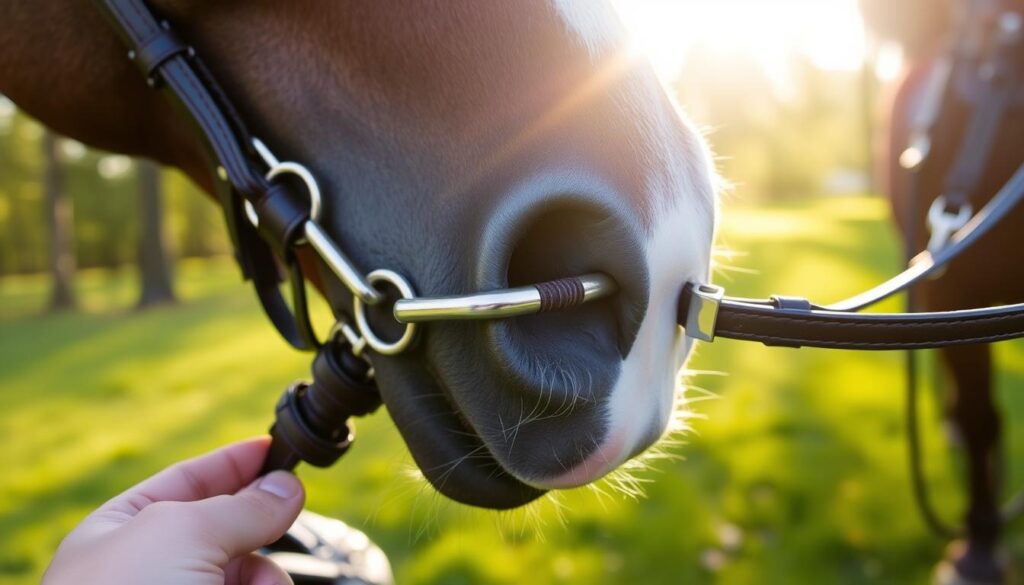Tom Thumb Bit: Guide to Horse Control Equipment

Did you know that nearly 25% of horse owners see bits as key for talking to their horses in equestrian sports1? The Tom Thumb bit is a top pick for Western riding. It’s not just for looks; it’s crucial for how riders and horses connect. Knowing about the Tom Thumb bit can really help in training and riding.
Exploring this bit, you’ll see how it helps in talking to your horse. It’s great for both new and experienced riders. If you want to improve your horse’s training or your riding, the Tom Thumb bit could be what you need.
Key Takeaways
- The Tom Thumb bit is particularly popular in Western riding disciplines.
- It is designed to enhance communication between horse and rider.
- The unique mouthpiece design encourages head lowering in horses.
- Understanding the components of the Tom Thumb bit is essential for effective use.
- This bit contrasts with other types, such as snaffle and curb bits, in its functionality.
Introduction to Horse Bits
Horse bits are key pieces of equestrian gear. They help riders talk to their horses during rides. These tools have changed a lot since 3000 BC, showing how much they’ve evolved.
Bits sit in the horse’s mouth, using pressure to send messages from the rider. This way, riders can guide their horses.
The Tom Thumb bit is a bit that people either love or hate2. It’s often suggested for new riders because it’s seen as gentle. But, some think it’s too harsh because of its design2.
Two-piece bits, like the Tom Thumb, can hurt the horse’s mouth. This might make the horse uncomfortable and cause problems like tossing its head or gagging2.
Bits come in different types, like snaffle and curb bits. Both are used in English and Western riding3. Snaffle bits help teach the horse to bend in different ways. Curb bits use leverage to control the horse’s jaw, with the severity depending on the shank length3.
Knowing about different horse bits helps you pick the right one for your needs. Whether for training or competition, choosing the right bit is important. It affects your horse’s comfort and how well it responds to you. For more info on horse bits, check out this comprehensive guide.
Understanding the Purpose of a Tom Thumb Bit
The Tom Thumb bit is special in the world of horse riding. It combines the direct action of a snaffle with the leverage of a curb. This mix helps horses respond better and sit up straight during rides.
The bit’s shank length is between five to seven inches. This length is key for the leverage effect. For every pound of pressure on the reins, the horse feels three times that. Knowing this is crucial for good riding4.
However, the Tom Thumb bit is not without debate. Some call it a “bad bit” because of its way of working. It can make the horse uncomfortable, leading it to lift its head or open its mouth5. Adjusting the curb chain right is important to avoid problems with the horse.
For young or new riders, this bit can be very helpful. It works well with certain horses. But, it’s wise to start with a mild snaffle bit first. This helps the horse feel comfortable and move freely.
As you get better, think about changing bits. This is especially true if you’re focusing on training or facing challenges with aggressive riding5.
Components of the Tom Thumb Bit
The tom thumb bit works well because of its special parts. These parts help the bit talk to the horse. Knowing about these parts can help you use the bit better during rides.
Mouthpiece Design
The tom thumb bit has a single joint mouthpiece. This design touches the horse’s tongue but not the palate. It makes the horse more comfortable and encourages them to relax their jaw6.
In Western riding, this bit is a step up from simpler bits. But, it’s only for riders who know how to handle issues like head tossing6. Brands like Weaver Leather and Professionals Choice make many types of mouthpieces. This makes the bit popular among riders7.
Shank and Curb System
The shanks of the tom thumb bit are medium length, between five to seven inches. They give the rider control without being too hard on the horse4. The curb straps are key to avoid too much pressure while riding.
The shanks can sometimes cause confusion in stopping and turning6. But, when used right, the bit can control even tough horses4. Riders must be careful not to misuse the bit, especially if they’re new6.
| Component | Description |
|---|---|
| Mouthpiece Design | Single-jointed design engaging the horse’s tongue and minimizing palate pressure |
| Shank System | Medium-length shanks (5-7 inches) that provide leverage |
| Curb Strap | Prevents excessive pressure during use, enhancing safety for the horse |
Knowing about these parts helps you use the tom thumb bit well. It makes riding better for you and your horse learn more here674.
Benefits of Using a Tom Thumb Bit
The Tom Thumb bit is a favorite among riders for good reasons. It helps with control and is key for training. Knowing the benefits of the Tom Thumb bit is crucial for better horse training and communication.
Encouraging Head Lowering
The Tom Thumb bit is great for teaching horses to lower their heads. This is important for balance and posture. It also helps horses connect better with their riders, making rides more enjoyable.
Improving Communication Between Horse and Rider
This bit makes talking to your horse clearer. Its design lets you send precise signals. This leads to a better partnership and more effective training sessions.
Learning about the Tom Thumb bit can improve your riding. For more on horse training gear, check out these resources.
| Feature | Benefit |
|---|---|
| Head Lowering | Helps in developing proper posture, balance, and frame. |
| Clear Communication | Enables precise rein signals and better understanding between rider and horse. |
| Control | Provides effective control for various training scenarios. |
| Versatility | Suitable for a range of riders, from beginners to advanced. |
Comparing the Tom Thumb Bit to Other Bits
Knowing about different horse bits can change how you ride and control your horse. The Tom Thumb bit is often compared to snaffle and curb bits. It’s key to see how they work, look, and feel on the horse.
Differences with Snaffle Bits
Snaffle bits and Tom Thumb bits talk to the horse in different ways. Snaffles use a jointed or hinged mouthpiece that doesn’t use leverage. This makes them seem gentler. But, some trainers misuse the term “snaffle,” causing confusion9.
The Tom Thumb bit has a jointed mouthpiece with shanks for leverage. This lets the rider communicate more clearly with the horse10.
Snaffles are good for starting new horses, but they can be uncomfortable. Some riders switch to the Tom Thumb bit or even try bitless riding10.
How it Stacks Up Against Curb Bits
The Tom Thumb bit is milder than curb bits, making it good for many riders. Curb bits use shanks and chinstraps for more control10. They work well but can be too harsh for some horses. The Tom Thumb bit is less severe and more comfortable for daily use9.
Riders need to know how horse bits work to keep both themselves and their horses comfortable. Choosing the right bit is key for a smooth ride.
| Feature | Tom Thumb Bit | Snaffle Bits | Curb Bits |
|---|---|---|---|
| Type | Jointed curb bit | Jointed or hinged mouthpiece | Solid mouthpiece |
| Leverage | Yes | No | Yes |
| Comfort Level | Moderate | Gentle | Varies |
| Training Use | Intermediate | Initial training | Advanced |
When to Use the Tom Thumb Bit

Knowing when to use the Tom Thumb bit can greatly affect your horse training. It’s great for moving a horse from a snaffle to a curb bit. It gives control and lets you communicate with your horse in detail.
Ideal Training Scenarios
The Tom Thumb bit is best used in certain situations:
- Training young horses that need steady guidance as they learn.
- Improving skills in older horses that need extra cues.
- Fixing specific behavior issues where more control is needed.
Choosing the right place and setting is key for success. It helps the horse get used to the Tom Thumb bit’s special features.
Considerations for Experienced Riders
Experienced riders should use the Tom Thumb bit carefully. It has a leverage system, so every pound of pressure feels like three to the horse4. If used wrong, it can cause discomfort and behavior problems4.
It’s important to have a soft and practiced hand. This makes the bit work better. Also, knowing your horse’s health and fixing training issues is crucial5. The Tom Thumb bit needs respect and skill, making it best for those who know its power.
Common Misconceptions about the Tom Thumb Bit
Many people in the horse riding world have wrong ideas about the Tom Thumb bit. Some think it’s only for young or new horses, but it works well with older ones too. Others believe it’s too harsh, so they don’t use it11.
It’s important to know the differences between bits. Not all snaffles are gentle, and not all curbs are hard11. Also, just because a bit has a joint in the middle doesn’t mean it’s a snaffle11.
The effectiveness of any bit is often more determined by your hands than the bit itself. This shows how key proper riding skills are in fixing any harshness12. Many riders think changing bits solves problems, but good training is what really helps11.
Riders often don’t understand the different types of bits, especially the difference between direct and leverage bits12. The Myler brothers’ bit system shows how new designs can make bits more comfortable and effective. They offer a variety for different training levels and horse needs12.
Not knowing these facts leads to myths that affect both horses and riders. The right bit fit and training are key for a horse to respond well to the bit11.
Tips for Fitting and Adjusting the Tom Thumb Bit

Getting the right fit for the Tom Thumb bit is key. It makes sure your horse is comfortable and you can communicate well. First, make sure the bit doesn’t pinch the horse’s mouth. You should see one wrinkle at the corner and fit two fingers between the headstall and the cheeks13.
Adjusting tack is also important. If it’s not right, it can hurt or confuse your horse. Check the curb chain to avoid too much pressure. Start with light cues to help your horse understand without fear14.
- Ensure the mouthpiece fits comfortably; look for signs of strain.
- Adjust the curb chain correctly to eliminate excess pressure.
- Begin training with light cues to reinforce understanding.
Pay attention to how your horse reacts when you first use the bit. If they respond well, it means you’ve fitted it right15. Practice side motion and stopping to help them learn the bit’s meaning14.
| Criteria | Ideal Measurement | Notes |
|---|---|---|
| Mouthpiece Fit | 1 wrinkle in the corner of the mouth | Allows for natural movement |
| Headstall Adjustment | 2 fingers between headstall and cheeks | Prevents pinching |
| Curb Chain Tightness | Snug but not painful | Avoids excessive pressure |
By following these tips, you can make sure your horse is comfortable. This will improve your riding experience by better communication.
Conclusion
The Tom Thumb bit is a versatile tool that can make horse riding better. It helps you communicate better with your horse, leading to better performance and comfort. Knowing how to use the Tom Thumb bit can help you succeed in horse riding.
Using the Tom Thumb bit can have different effects on different horses. Some riders have seen great results, showing it works well for some horses16. But, not all experiences are positive, and some riders have to try other options17.
When choosing riding gear, think if the Tom Thumb bit is right for your horse and riding style. This ensures a safer and more effective ride. It also strengthens your bond with your horse on the path to equestrian success.
FAQ
What is a Tom Thumb bit?
What disciplines is the Tom Thumb bit used in?
How does the Tom Thumb bit work?
What are the benefits of using a Tom Thumb bit?
Is the Tom Thumb bit suitable for all horses?
How does the Tom Thumb bit compare to snaffle bits?
What should I consider when using the Tom Thumb bit?
What are common misconceptions about the Tom Thumb bit?
How do I fit and adjust the Tom Thumb bit correctly?
Source Links
- https://afs.ca.uky.edu/horse-discovery/bits – Horse Discovery – Bits | Animal & Food Sciences
- https://aminoapps.com/c/equestrian/page/blog/tomthumb-bits-controversial-bit-talk/RdoE_Z6fwuW8nrqroEmPrn00ZXaLwlQQmN – TomThumb bits (controversial bit talk) | Equestrian Amino
- https://aussiesaddlery.com.au/bit-guide/?srsltid=AfmBOooZH2vNBVKaI3Cet18DuAjAprkf-poN7ItOQSyXAPgA4Hmom_tm – Bit guide
- https://www.thesprucepets.com/action-and-uses-of-a-tom-thumb-bit-1886070 – Is the Tom Thumb Bit Causing Discomfort to Your Horse?
- https://signin.juliegoodnight.com/articles/free-articles/talk-about-tack-understanding-bits-tom-thumb/ – Talk About Tack: Understanding Bits– Tom Thumb | Julie Goodnight Academy
- https://nickernews.net/wp-content/uploads/sites/19/2019/12/tomthumb.pdf – Microsoft Word – The Trouble with Tom Thumb.doc
- https://www.tackwarehouse.com/western-tom-thumb-horse-bit-s/2012.htm – Western Tom Thumb Horse Bit
- https://horserookie.com/horse-bit-guide/ – Bit by Bit: A Helpful Illustrated Horse Bit Guide – Horse Rookie
- http://abitaboutbits.blogspot.com/2011/03/tom-thumbs-and-argentine-snaffles_20.html – Tom Thumbs and Argentine Snaffles
- https://westerntrailrider.com/wordpress/blog/2018/05/lets-talk-about-bits/ – Let’s talk about bits… | Western Trail Rider
- https://signin.juliegoodnight.com/articles/free-articles/talk-about-tack-understanding-bits-myler/ – Talk About Tack: Understanding Bits– Myler | Julie Goodnight Academy
- https://signin.juliegoodnight.com/articles/free-articles/julies-blog/the-right-bit-in-the-right-hands/ – The Right Bit In The Right Hands | Julie Goodnight Academy
- http://notanotherhorseblog.blogspot.com/2013/09/proper-bit-fit-shanked-snaffle.html – Proper Bit Fit: Tom Thumb vs. Shanked Snaffle
- https://www.horseforum.com/threads/tom-thumb-bit.788725/ – Tom Thumb Bit
- https://www.newrider.com/threads/tom-thumb-bits-confused.78812/ – Tom thumb bits – confused
- https://www.horseforum.com/threads/tom-thumb-bit-bad-why.525137/ – Tom Thumb Bit, Bad? why?
- https://forum.chronofhorse.com/t/trail-bit-question/118755 – Trail bit question



